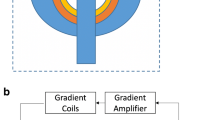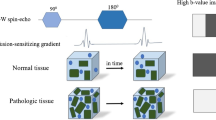Abstract
Magnetic induction tomography (MIT) is a non-invasive modality for imaging the complex conductivity (σ) or the magnetic permeability (μ) of a target under investigation. The critical issue in the clinical application of the detection of cerebral hemorrhage is the determination of intracranial hematoma status, including the location and volume of intracranial hematoma. In MIT, the reconstruction image is used to reflect intracranial hematoma. However, in medical applications where high resolutions are sought, image reconstruction is a time- and memory-consuming task because the associated inverse problem is nonlinear and ill-posed. The reconstruction image is the result of a series of calculations on the boundary detection value, and the color of the reconstructed image is the relative value. To quantitatively and faster represent intracranial hematoma and to provide a variety of characterization methods for MIT dynamic monitoring, one-dimensional quantitative indicators are established. Our experiment results indicate that there is a linear relationship between one-dimensional quantitative indicators. The change of the detection value can roughly determine the location of the hematoma.

Graphical Abstract



















Similar content being viewed by others

References
Ma L et al (2017) Magnetic induction tomography methods and applications: a review. Measurement Science & Technology 28(7):1–9
Zolgharni M et al (2009) Imaging cerebral haemorrhage with magnetic induction tomography: numerical modelling. Physiol Meas 30(6):187–200
Li F et al (2017) Total variation regularization with split bregman-based method in magnetic induction tomography using experimental data. IEEE Sensors Journal 17(4):976–985
Sadleir RJ et al (1998) Quantification of blood volume by electrical impedance tomography using a tissue equivalent phantom. Physiol Meas 19(4):501–516
Sadleir RJ, Fox RA (2001) Detection and quantification of intraperitoneal fluid using electrical impedance tomography. IEEE Trans Biomed Eng 48(4):484–491
Frerichs I, Dargaville PA, Dudykevych T, Rimensberger PC (2003) Electrical impedance tomography: a method for monitoring regional lung aeration and tidal volume distribution. Intensive Care Med 29(12):2312–2316
Mamatjan Y, Grychtol B, Gaggero P, Justiz J, Koch VM, Adler A (2013) Evaluation and real-time monitoring of data quality in electrical impedance tomography. IEEE Trans Med Imaging 32(11):1997–2005
Meng L et al (2015) One-dimensional index extraction based on electrical impedance tomography system. Chinese Medical Equipment Journal 36(7):9–12
Lei W et al (2016) Preliminary research on electrical impedance tomography for gastric motility function detection. Chinese Medical Equipment Journal 37(5):1–4
Tang T, Weiss MD, Borum P, Turovets S, Tucker D, Sadleir R (2016) In vivo quantification of intraventricular hemorrhage in a neonatal piglet model using an EEG-layout based electrical impedance tomography array. Physiol Meas 37(6):751–764
Dekdouk B et al (2010) A method to solve the forward problem in magnetic induction tomography based on the weakly coupled field approximation. IEEE Trans Biomed Eng 57(4):941–921
Griffiths H et al (1999) Magnetic induction tomography: a measuring system for biological tissues. Ann N Y Acad Sci 873(1):334–345
González CA et al (2006) The detection of brain oedema with frequency-dependent phase shift electromagnetic induction. Physiol Meas 27(6):539–552
Scharfetter H, Casañas R, Rosell J (2003) Biological tissue characterization by magnetic induction spectroscopy (MIS): requirements and limitations. IEEE Trans Biomed Eng 50(7):870–880
Simpson JC et al (2001) “Simple analytic expressions for the magnetic field of a circular current loop.”, NASA Kennedy Space Center, GCN-00-26,
Qiang D (2013).“Study on key technology of sector array magnetic induction tomography system.”, Doctoral dissertation, Shenyang university of technology,
Gao Y et al. (2016) “Intracranial fine simulations based on a four layers craniocerebral model.”, International Conference on Biomedical Engineering and Informatics. IEEE :19–23
Dannhauer M et al (2010) Modeling of the human skull in EEG source analysis. Hum Brain Mapp 32(9):1383–1399
Bashar MR, Li Y, Wen P (2010) Effects of local tissue conductivity on spherical and realistic head models. Australas Phys Eng Sci Med 33(3):233–242
Li K et al (2016) Establishment of a four layer complicated ellipsoid brain model. Chin J Biomed Eng 35(1):55–62
LI Y et al (2009) Precise synchronous phase measurement method in magnetic induction tomography. Chinese Journal of Scientific Instrument 4(30):796–801
Zhili X et al. (2017) Brain tissue based sensitivity matrix in hematoma imaging by magnetic induction tomography, IEEE International Instrumentation and Measurement Technology Conference IEEE, :1–6
Funding
The National Nature Science Foundation of China (51377109). The Nature Science Foundation of Liaoning Province (LZ2014011).
Author information
Authors and Affiliations
Corresponding author
Additional information
Publisher’s note
Springer Nature remains neutral with regard to jurisdictional claims in published maps and institutional affiliations.
Rights and permissions
About this article
Cite this article
Ke, L., Zu, W., Du, Q. et al. A bio-impedance quantitative method based on magnetic induction tomography for intracranial hematoma. Med Biol Eng Comput 58, 857–869 (2020). https://doi.org/10.1007/s11517-019-02114-7
Received:
Accepted:
Published:
Issue Date:
DOI: https://doi.org/10.1007/s11517-019-02114-7



